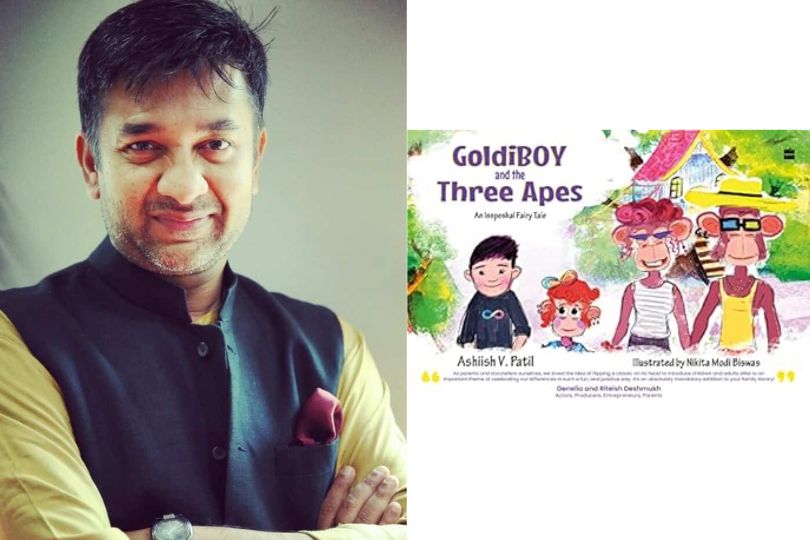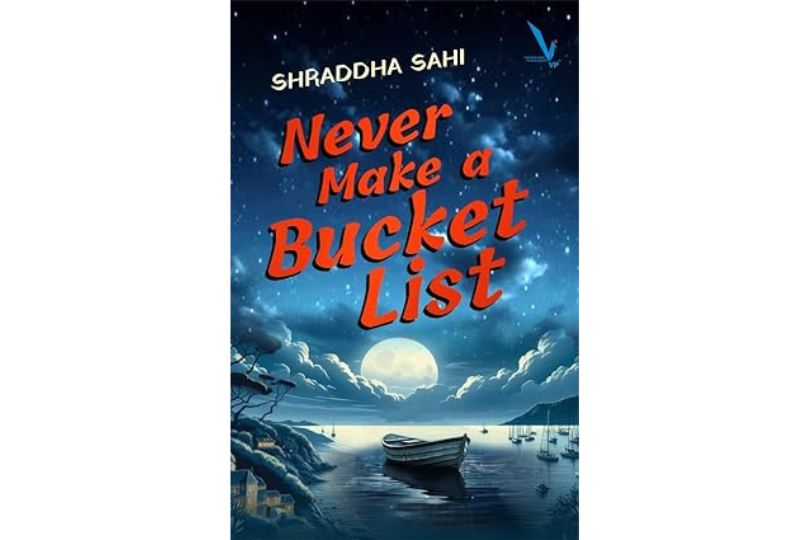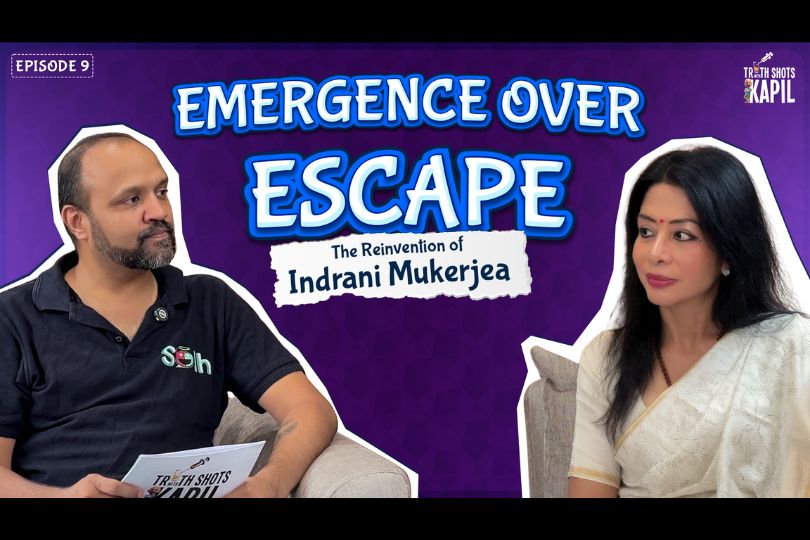Interview with Ashiish V. Patil, Author of “Goldiboy And The Three Apes”
Explore Ashiish V. Patil's exclusive interview on Frontlist, where he shares insights about his fantasy book 'Goldiboy and the Three Apes.'on Sep 18, 2023

Frontlist: Can you briefly overview your book "Goldiboy and the Three Apes"? Who is this book for, and what message do you hope the readers should take away from it?
Ashiish: "Goldiboy and the Three Apes" is a fun new picture book, a modern-day take on the classic Goldilocks fairytale. It features a bunch of amusing and colorful characters, including the Ape family and a lovely young boy called Goldiboy. It has many contemporary references, from Billie Eilish and Bollywood to iPads and more. The book also has over 100 gorgeous hand-drawn illustrations and introduces kids and adults alike to the magical world of neurodiversity and autism in the simplest, most fun manner. I hope the readers enjoy a fun story and learn to recognize, accept, appreciate, and celebrate differences in all of us, be it race, religion, gender, ability, or more. In that respect, it's a book for everyone because it's never too early or too late to learn about neurodiversity.
Frontlist: How do you think "Goldiboy and the Three Apes" can help people identify and understand neurodiversity individuals?
Ashiish: When things are a little familiar, they become a lot more accessible. And our book is a modern-day take on the classic tale. As is often the case with invisible disabilities, it's very likely you know someone with autism and don't even know it. In the same way, when the original author of Goldilocks wrote her character, they (since there's no single creator identified/attributed to the story) didn't even realize they were writing a character with 'sensory sensitivities,' who find things' too hot,' 'too cold,' 'too hard,' 'too soft' and is probably neurodivergent. It was a simple, logical extension when we modernized it – but we emphasized these things.
The gender switch from Goldilocks to Goldiboy is because the character is inspired by our son, Risshan, who is on the autism spectrum.
Frontlist: The book introduces readers to a world of anthropomorphic animals. What drew you to this unique setting, and how did you approach crafting a society and environment for these characters?
Ashiish: Besides looking really cool, like those Bored Ape NFTs, the apes are where we've evolved from. They're misunderstood, playful, positive, warm, friendly, fun. The book needed to be bright, happy, and colorful, just like the magical, colorful world of neurodiversity. Hence, the choice of settings and colors mirrors that – neon, up-tempo, positive: a tree house, primary colors, wood, leaves, and lots of sunlight. Small nuances, be it the autism infinity symbol to the logo on the iPad being a peeled banana instead of a half-bitten apple. King Kong posters in the room because it's a beautiful love story of a human and an ape. The detailing has been done with very conscious choices in all aspects, for instance –
- The book that Papa Ape is reading is "Thinking in Pictures" by Temple Grandin – an autism legend.
- The podcast Mama Ape listens to is quite popular in the community – Spectrumly Speaking Podcast.
- The pop star Baby Ape is bopping to a neurodivergent artiste with Tourette's Syndrome – Billie Eilish.
- Other details like the positive/affirmative language used, the phrases from therapy (learning to be flexible/brain left the group), the choice of diet (gluten-free), the weighted blanket, the scooty being an EV
- Of course, the usage of the autism infinity symbol across – be it Goldiboy's T-shirt, Baby Ape's hairclip, the butterflies, the slides in the playground, the gestures/hand symbols.
We spent a year illustrating the book. Unlike most traditional children's picture books, which are 24 to 40 pages, this one is over 130. We wanted each frame to look like rainbow confetti for the eyes – bright, happy, meaningful. Hopefully, readers will feel that vibe as well.
Frontlist: "Goldiboy and the Three Apes" delves into themes of awareness and acceptance of autism. Can you elaborate on how these themes are interwoven into the narrative and the lessons they offer readers?
Ashiish: Storytelling is the most powerful way to introduce new ideas to bring change. No one is interested in a sermon or a speech. Do it through a story or a song: Firewalls Drop. And that's precisely what we've attempted. It's a fun story to begin with, which also happens to feature characters that are neurodivergent. It shows you that autism has many faces. And that you will find differences all around you in life society. It encourages you not to fear those. But to recognize them. Accept them. Appreciate them. Celebrate them.
The narrative does that by simply introducing Goldiboy in the most fun manner, where you see how he's so much like any other kid – loving his mom, pizzas, and music. But at the same time, a little different. And how he's different. What bothers him is how he sees, hears, and feels things differently. And then throwing a curveball through a twist that's seeded but you possibly don't see coming up ahead as you find out, hey, Baby Ape's neurodivergent too. It does this without making any judgments, and through that. Hopefully, it helps people in the community/on the spectrum feel seen/heard. It helps them to belong and feel accepted. And for everyone else, neurotypical folks and more – helps them understand and also shows them how to normalize things.
Frontlist: Goldiboy embarks on a journey of personal growth throughout the story. Could you discuss the development of Risshan as a protagonist and the challenges he faces that lead to his transformation?
Ashiish: Risshan, our son, is my hero. He has made me not just a better dad but a better man. I am amazed to see how he lives life in such an authentic manner. He doesn't judge people based on their looks, wealth, color, religion, or possessions. He does that purely based on their behavior with him and the rest of the world. What an incredible way to be. I wish we could all learn to do that.
On his journey, Risshan has learned to recognize some of his challenges and find a way to work around them – like auditory sensitivity, noise-cancellation headphones, sensitive gut, hence a gluten-free, dairy-free diet, etc. And he's learned to use his strengths to his advantage, like his music, singing, and wicked sense of humor. These are his tools to calm his social anxiety, express himself, and connect with people.
Goldiboy does that with his golden smile and innocence.
Frontlist: Creating a world with anthropomorphic animals requires balancing relatability and fantasy. How did you approach developing characters that readers could connect with while still maintaining the unique qualities of this animal society?
Ashiish: We have yet to see too many neurodivergent characters as anthropomorphic animals. But apes are the origin stories of humans since that's where we began/evolved from – so it was a seamless transition. Give them cool, contemporary clothes and accessories – hats, clips, sunglasses, clothes. All this does have a sense of heightened, hyper-stylized, enhanced reality. But they're still rooted in regular, daily activities. So, it's relatable/believable yet enjoyable.
Frontlist: Mental health plays a significant role in your book. How did you infuse humor into the narrative, and why do you believe it's essential for a story like "Goldiboy and the Three Apes"?
Ashiish: You really can't bore people into understanding and appreciating anything. I mean, look at all our academic textbooks. A children's storybook really couldn't afford to be a snooze fest. And humor is a potent tool to jump firewalls, to drop truth bombs – even if uncomfortable at times – and that comes very naturally to me. I also tend to write just like I speak. So, draft one was anyway inherently fun/funny. Then, as we did follow-up passes, the rhyme came in – it's written like a fun rap. And the color characters only added to the fun.
Frontlist: The story emphasizes the importance of embracing differences and finding common ground. What message do you hope readers will take away from this aspect of the narrative?
Ashiish: There are special schools, but there is no special world. No separate bubble. Neurodivergents and Neurotypicals. And people and beings of all kinds have to live together in the same world. So, we must learn to recognize, accept, and appreciate differences vs. fear and discriminate against them. Only then will the world become a more inclusive, "isspeshal" place.
Frontlist: "Goldiboy and the Three Apes" appears to hold a mirror to real issues and dynamics faced by autistic people. How can using a fictional setting sometimes allow for a more profound exploration of societal complexities?
Ashiish: We have too much reality in our lives anyway. And at times, a fun story that seems unreal can REALLY show us our true selves and realities. With fiction and animated/illustrated characters, you can push the envelope in your storytelling. Besides making it more exciting and entertaining, it can allow you to see things you may have missed or not noticed otherwise. The wandering mind during meetings, the difficulty in making friends, the making fun of others, the joy of music and dance, some of these things in this avatar become far more palatable, acceptable, and engaging. And then the penny drops with, "Oh gosh, that's probably me!"
Frontlist: As the author & father, what personal challenges did you face while articulating "Goldiboy and the Three Apes"?
Ashiish: There are two types of writing—one is outside, where you observe the world and comment about it. The second is inside out. This book is that. It was inside me, and it probably took a pandemic, a couple of lockdowns, and a week of quarantine after testing COVID-19 positive for it to HAVE to break free from inside of me!
At some level, it was cathartic to put it out as a story. Because our son and his lived experiences so profoundly inspired it. By things, I've seen, experienced, felt as a late-diagnosed autistic myself. Things that are fulfilling and gut-wrenching. Things that are fun, things that are heartbreaking. And things that restore your faith in humanity. And yourself.
To see someone "different" get picked on/bullied, or to see a condition stigmatized, to see the difficulties people on the spectrum have made friends – it's very, very hard.
But then, you'll see their purity and positive outlook. And stumble upon people who are nice, accepting, and without agendas. You'll see the change in people once they understand. You'll see bonds and the needle moving forward just a little – I mean, the journey of educating the world about neurodiversity is not a sprint; it's a long marathon. But worth it.
In pop culture, be it movies, series, TV shows, music videos, or books – disability in general and neurodiversity in particular have largely been absent. Not under-represented – just missing. What exists is probably worse, which is misrepresentation, like narratives that are based on pity, inspiration, or just downright insensitive. Playing up disabilities for gags, humor, as the butt of jokes. Globally, there are very few books (less than 30 probably) in this format to introduce children and adults to this concept. What exists is an academic or a bit of a sob story, a personal memoir.
Rather than complaining about that, I thought, why not do something to fix that – hence the book happened. And I wanted to make sure I got the nuances right. So, besides putting out a very personal, vulnerable side of us, I had to ensure that we got the content detailing right. Some of the most respected names in the neurodiversity and autism community have fortunately come in and endorsed our efforts.
I also wanted to make sure that it's entertaining and looks fantastic. So, finding the right illustrator was vital. I lucked out with Nikita [Modi Biswas], an art teacher from NOIDA, UP. She just "got" the material and poured her heart into every page, every sketch. Her style, which is so childlike, raw, and unfinished, is just what I needed for this book. I'd say she was "JUST RIGHT" for it.
And then, of course, making sure the book gets out there to as many people as possible through the right partner. HarperCollins fortunately came in just in time to help give it a global platform.
All the author's earnings from this book are going to a center for autism – so it's been quite a ride. And so worth it, given the feedback we're getting on the book.



.jpg)






.jpg)

.jpg)
.jpg)


.jpg)
.jpg)

.jpg)










Sorry! No comment found for this post.